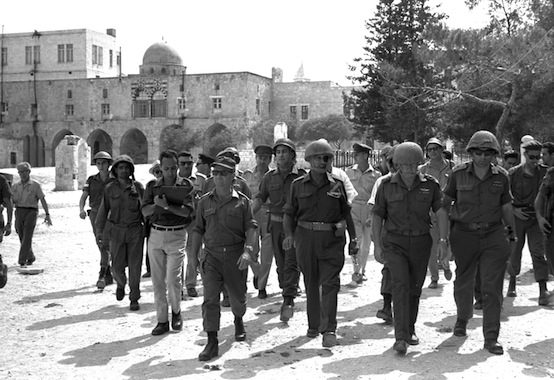Little Platoons in Israel

When I finished reading Like Dreamers, Yossi Klein Halevi’s big new book, I thought: he picked the wrong title.
He tells the story of post-1967 Israel through the biographies of the men of the IDF’s 55th paratroopers’ brigade, following them from adolescence through their army service down to the 40-odd years of life, love, politics, and poetry that have absorbed them since the battle that, as Halevi tells it, made them the perfect symbol for the young Israeli nation.
These were the victorious warriors in the battle for the Old City of Jerusalem, the men in the famous photo of awestruck, teary-eyed soldiers standing at the Western Wall for the first time since the founding of the state. The book’s concept pretty much sells itself: the most profound event since Israel’s founding was the victory in ’67, and the primal symbol of that victory was the return to old Jerusalem.
What kinds of men were these, and what path did they chart from that fateful moment in Israel’s history, Jewish history, and world history? And what does their trajectory tell us about the trajectory of the nation they were raised to lead?
My initial assumption was that the title played on the old line about Britain acquiring an empire in a “fit of absence of mind.” Far from being part of some grand plan, the conquest of the West Bank, and even of the Old City of Jerusalem, was very much an improvised response to events. The initial Israeli preoccupation was to neutralize the Egyptian threat—the 55th paratroopers themselves spent the weeks prior to the battle for the Old City preparing for a mission in the Sinai, and only a last-minute change of plans sent them to Jerusalem, where they were at first tasked only with relieving the Hadassah hospital enclave on the Jordanian side of no-man’s land. It was only after the extent of their early victory against Egypt was clear that Israel sought to capitalize on that success with action on other fronts. One could plausibly say that the conquests of the Six Day War were made as if in a dream. If so, perhaps the book would take readers on a journey from dreams to wakefulness.
As Halevi explains, though, the title refers only partly to the sense that the war’s victories happened as if in a dream, and more centrally it refers to the dreams that led the IDF to take the Old City and those that followed victory. The conquest itself was undertaken as a fulfillment of a 2,000-year dream, the capstone achievement of the return to Zion. And once one dream was accomplished, it made other dreams seem real. Perhaps Israel’s permanent presence in the region could be secured on terms of Israel’s dictation. Perhaps the state of Israel would finally possess the entirety of the Land of Israel. For those of a literally messianic bent, the final and complete redemption of the human race might even be at hand.
These are not dreams that you wander in and wake from surprised to discover yourself in a beautiful house, with a beautiful wife, saying, “how did I get here?” They are dreams that you follow, that motivate action—dreams that become so much more real to you than life that after living in them long enough you come to measure life’s own reality according to how well it corresponds to your dream.
It’s an interesting frame within which to tell the story of post-1967 Israel. Because that kind of dream is what we would more commonly call an ideology.
Most of the men of the 55th paratroopers were raised on kibbutzim, ideologically-oriented agricultural collectives that were a principal vehicle for achieving many of labor Zionism’s objectives for transforming the Jewish people. As model utopian socialist communities, they embodied the hope for a radical transformation in economic relations.
As agricultural communities, they rooted their members in the land, transforming the children of peddlers and artisans into a peasantry—and a formidable militia. Not coincidentally, they proved the natural training ground for the IDF’s officer corps.
You would expect men from such a background to have a profoundly ideological outlook on life, but what’s interesting is for most of them—at least those whom Halevi followed—that turns out not to be the case. One, Arik Achmon, turns his back on a socialism that never fit his personality particularly well to become first the CEO of a start-up private airline and then, after losing a boardroom power struggle, a business consultant. He has political opinions, strong ones, but he does not live for them. Another, Avital Geva, becomes a conceptual artist who eventually immerses himself in a project, a greenhouse, that is one part representation and one part exemplification of the kibbutznik ethos—if that ethos were entirely an exercise in the art of living and not at all a practical component of state-building. He is living for a cause, but he may be the only one who fully understands it. Yet another, Meir Ariel, a singer-songwriter, comes to be known as “the Israeli Bob Dylan” (though “the Israeli Leonard Cohen” sounds more like it).
For all their collectivist upbringing, in other words, these kibbutzniks followed dreams that were distinctly private and idiosyncratic. The only one who arguably lived his life for a cause not of his own construction was the extreme left-wing radical Udi Adiv. And even that case requires an asterisk: while still a young man, Adiv was convicted of spying for Syria, and after a decade in prison he emerged thoroughly chastened, awake from that particular dream.
The true dreamers were another group from the 55th, the more religious soldiers who are initially condescended to by the secular kibbutzniks: Hanan Porat, Yoel Bin-Nun, and Yisrael Harel. These three helped found and lead Gush Emunim, the “bloc of the faithful” that settled the newly conquered territories. These men’s conception of themselves is as the ones who did not forget the original dream—the ones whose lives were guided by a collective purpose for which they would sacrifice anything. And whether with grudging admiration or dismay—or, often, both—the kibbutzniks come to regard them that way as well.
One of Halevi’s signal achievements is to take us inside these settlers’ minds, help us understand how they see the world, and see them as human. Which they are: they argue with each other, assess the practical consequences of their actions, feel shame and remorse as well as pride and joy. Even their dangerous blind spots—there are terrorists and fascists in their midst, and only one of them really seems to recognize the implications of that fact—are laid before the reader neither condemned nor excused, so we see them as part of the human picture.
But these men are distinct in that, for them, their dream has a reality as fully consequential as the reality of stones and human beings. Halevi sees an equivalence between this dream and the dream of peace that, he says, the left pursued with equal fervor. But it’s an equivalence I don’t see played out in the lives of the titular dreamers.
That’s one reason I don’t think he picked the right title. But the other reason is that he had a better title to hand. There is a word that crops up over and over in the book, so often and in such significant contexts that it became a kind of synecdoche for the book itself. He should have called it The Last Chevreh.
As the most pregnant expressions often are, “chevreh” is not perfectly translatable. It’s a collective noun that derives from the word chaver, which means “friend,” but it doesn’t mean merely a circle of friends. It’s often translated as “gang,” but that word has a sinister connotation and is missing an implied sense of common purpose, a penumbra emanating from etymological kin like chevrah—as in chevrah kadisha, the “holy society” responsible for tending to the earthly remains of the dead.
The chevreh is the group, a group of peers bound by common experience and subject to the kind of mutual obligation incumbent upon members of a family or of a platoon.
It’s a word that defines the kibbutz experience in an essential way, particularly the experience of growing up on a kibbutz; it’s also a word that defines the experience of serving in the army. And it’s a word that defines, particularly for men like these, the experience for being Israeli—more, the essential meaning of Israel itself.
As plainly it does for Halevi. Although he is frank about the profound political divisions sown by the settlement enterprise, the overwhelming thrust of the book is towards a counter-narrative, one that emphasizes the ongoing unity of the chevreh notwithstanding its division into different political camps.
Paratrooper Arik Achmon, who sees the settlements as a tragic mistake, cannot help but also see them as the only surviving example of the pioneering spirit. Yoel Bin-Nun, settler leader, is also strongly supportive of the Yitzhak Rabin government—in part because he is convinced Rabin will not uproot settlements, but more because he is convinced this man is part of the chevreh and sees the entire nation, settlers included, in those terms. Repeatedly, Halevi points out that the religious Zionist paratroopers are not separatists like the ultra-Orthodox, and they consider secularists to be their brothers, not their enemies. 
It’s a powerful idea, the chevreh, and it’s beautiful to see the bonds of love that endure in this platoon across these vast political divides. And as a political metaphor it still has legs. In their own different ways, Yair Lapid and Naftali Bennett, rising Israeli political stars of the center and right respectively, both partake of that metaphor, both speak to an Israel that might think of itself as one chevreh—with disagreements, of course, even profound ones, but as a single group.
But as a political principle, I question how well tailored it is to the challenges of today’s Israel.
Reading Like Dreamers felt at times like watching “The Big Chill,” another portrait of a group of friends standing in as a portrait of a generation—indeed, the same generation that shook the social and political foundations of cities as diverse as Prague, Paris, and Chicago.
And this book has the same profound limitations in that no group of this sort is likely to be actually representative. The members of the 55th whom Halevi follows are, needless to say, all men. They are also all Ashkenazi Jews. They are all either secularist or religious Zionists. There are no ultra-Orthodox Jews; no Russians or Ethiopians or even Sephardi or Mizrahi Jews. Needless to say, there are no Arabs.
These are not trivial exclusions. Halevi tells a story about a country awakening from certain dreams—of conquest or of peace—that sent the 55th paratroopers to Jerusalem and shaped their lives for decades after. But it is impossible to understand the political and social evolution of Israel in the post-’67 period without reference to the Sephardi/Mizrahi awakening, or the massive Russian immigration, or the rise of ultra-Orthodoxy. They have different dreams—if the metaphor of dreaming even fits.
And it is impossible to talk honestly about the nature of the state without involving the Arab citizenry in the conversation as active participants.
But they are not part of the chevreh.
Senior editor Noah Millman blogs at TheAmericanConservative.com/Millman.
Comments